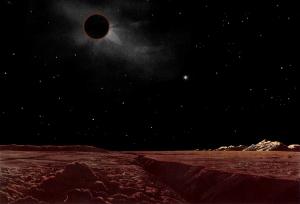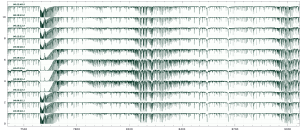Blog
Shadow of the Earth
4 March 2020
 Lucien Rudaux
Lucien RudauxThere are several ways to look for alien life on distant worlds. One is to listen for radio signals these aliens might send, such as SETI and others are doing, but another is to study the atmospheres of exoplanets to find bio-signatures of life. But what might these signatures be? And what would they appear to our telescopes?
Ideally, it would be nice to observe an exoplanet where we know life exists, and study how it appears compared to other, lifeless exoplanets. The problem is, there’s only one planet known to have life, and we’re on it. We can’t travel light-years away and then observe Earth as if it were an exoplanet. But we can do the next best thing: observe the light passing through Earth’s atmosphere during a lunar eclipse.
 ESA/CESAR–M.Castillo
ESA/CESAR–M.CastilloA lunar eclipse occurs when the Moon passes into the shadow of Earth. It typically takes on a deep red glow because of Earth’s atmosphere. During a lunar eclipse, the Earth completely blocks the Sun as seen from the Moon, but some sunlight passes through Earth’s atmosphere and is refracted toward the Moon. If you were standing on the Moon during a lunar eclipse, you would likely see Earth a ring of fire. A red glow of air-filtered sunlight.
This filtering effect is how we study the atmospheres of exoplanets. When an exoplanet passes in front of its star, some of the starlight passes through the planet’s atmosphere. Atoms and molecules in the atmosphere absorb certain wavelengths of light depending on their composition. By studying the absorption lines of the atmosphere astronomers can detect molecules such as water or carbon dioxide.
 AIP/Strassmeier
AIP/StrassmeierDuring the total lunar eclipse of January 2019, a team of astronomers studied Earth’s atmosphere as if it were an exoplanet.1 They didn’t observe Earth from the Moon, but rather looked at the spectrum of light reflected from the Moon’s surface. By observing the spectrum of this reflected light, the team found strong signatures of water and oxygen. From high-resolution spectral observations, the team also found traces of sodium, calcium, and potassium.
This study doesn’t tell us anything new about our atmosphere, but it does show how even trace elements can be found in the atmosphere of an exoplanet. This could play a key role in discovering life elsewhere.
Strassmeier, K. G., et al. “High-resolution spectroscopy and spectropolarimetry of the total lunar eclipse January 2019.” Astronomy & Astrophysics (2020). ↩︎